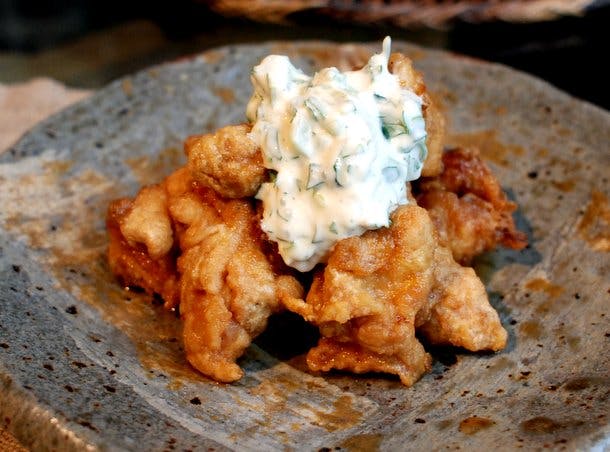
kyushu style fried chicken
Learn a unique recipe for fried chicken with a Kyushu style marinade and Kansai-style pickled eggplant tartar sauce. The recipe showcases modern Japanese cooking techniques and ingredients influenced by Western and local flavors.
Takako Kuratani is a prodigious chef who designs menus for Japanese restaurants around the world, styles food for Japanese movies and TV commercials, develops recipes, teaches Japanese cuisine -- and never stops cooking and experimenting. I was fortunate to meet her last year at her test kitchen in Tokyo where she and her team treated me to a fantastic dinner. (Ah, the joys of writing... :)) Besides being incredibly talented, Takako is utterly gracious and kind, and thorough emails has been teaching me about Japanese ingredients and cooking. She just visited New York and one of the things she brought with her was a slender red notebook -- her own personal cookbook, where she records her recipes and cooking inspiration. While she was here, Takako planted herself in a kitchen, cracked opened that little red book and prepared a wonderful homey dinner for a bunch of friends. Her theme: the down-home cooking of Kyushu, Japan's own Deep South.
I asked Takako to share a recipe for one of her dishes, and she graciously offered her take on fried chicken -- hey, appropriately Southern! What I found fascinating about this dish is that instead of marinating the chicken, coating in egg and rolling in flour, the way I expected it to go, Takako prepared the chicken the other way around: She dusted it in flour, then coated it in egg and, after deep frying, dipped it in the marinade. It's a technique that evokes tempura. Takako explained that this is a Kyushu style of deep frying that produces really tender chicken. Tender -- and absolutely delicious.
Another interesting thing about this dish is how ingredients and foods adapted from the West, like ketchup, mayonnaise and tartar sauce, have made their way into modern Japanese cooking, but with a uniquely local twist: A traditional rouge-colored Kyoto pickle, for example, replaced the capers of a typical tartar sauce. And the marinade calls for the imaginatively (!) named Vegetable and Fruit Sauce, a condiment that seems distantly related to prepared barbecue sauce.
Here's the recipe.
Marinade
1/3 cup vinegar
1/3 cup mirin
2T soy sauce
4T sugar
1 T ketchup
1T Vegetable and Fruit Sauce (available at Japanese food stores)
squeeze lemon juice
salt and pepper to taste
Chicken
2 lb thigh and legs deboned
Salt and pepper
Unbleached flour
1 egg, lightly beaten
1 quart cooking oil (rice bran, canola or other high smoke point vegetable oil)
Tartar Sauce
1C mayonnaise (homemade if you can)
2 boiled eggs, chopped
2T chopped onions
2T chopped shibazuke (Kyoto-style salt-pickled eggplant, available at Japanese food stores)
2T chopped parsley
Salt and pepper to taste
Cut the chicken into bite-sized pieces, salt and pepper and set aside.
Heat oil in a saucepan over medium flame. The oil should be at least two or three inches deep, for deep frying.
Prepare the marinade by mixing all the ingredients in a bowl. Set aside.
Prepare the tartar sauce by mixing all the ingredients in a bowl. Set aside.
Deep fry the chicken: Lightly coat the chicken with flour. Break off a tiny piece of the chicken and drop in the oil to check the temperature. When the piece sizzles and floats to the top, the oil is hot and ready (See the May '08 issue of Savuer, p. 104, for more on how to gauge oil temperature without a thermometer). Cook the chicken in batches. Dip a piece of the flour-coated chicken in the egg mixture and gently ease into the oil. Repeat with other pieces, adding them to the oil until you have enough in there without overcrowding. If you add too much chicken at once you'll drop the temperature of the oil and the pieces will fuse together. Cook for about four to five minutes, until the color turns to golden brown. Transfer to a plate lined with paper towel and deep fry the rest of the chicken.
To serve, dip the fried chicken in the marinade to coat, and arrange the pieces on a serving plate (hopefully a nice rustic piece of Japanese pottery!). Pour the tartar sauce over the chicken. Eat while it's hot.
One note: My local Japanese market was out of shibazu
